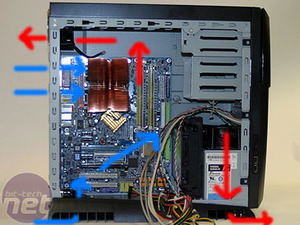
Performance


This is the theoretical airflow of the Silentium T1. Cooler air enters the case through the mesh air vents at the rear of the case and through the unique grill at the bottom of the case. This lower grill also feeds cool air to your graphics card; if you have a dual-slot card like a X1900 or GeForce 7900 GTX, this design is perfect as the hot air vented out the second backing plate is replaced with cool air from below. The unique PSU placement vents warm case air out the front of the case using the front grill underneath.
Booting this system for the first time produced a brief moment of panic. Having screwed everything together, we poked the large On button at the front and for a few seconds, nothing happened: no whizzing; no whooshing. No noise of any kind. Normally, under these circumstances, we would discover that the wall socket was switched off or some similar basic mistake. However, when the Windows loading screen appeared on our display, we were taken aback - this system was powered on.
We don't have a sound-proof booth and the sophisticated microphone rigs needed to accurate measure the acoustic performance of a case but even if we did, that would only produce a number. Instead, we utilised the power of eight human ears to judge the noise of this case. The reactions were largely unprintable but judgement was unanimous: this case is eerily silent. Even under load, the case remained cool and quiet - the CPU fan barely throttling above its idle speed.
Value
The Arctic Cooling Silentium T1, as supplied, is available in the UK from Kustom PCs for Kustom PCs £62.00 inc vat. The list price in the US is $129 and though we found it for $119.99 at Xoxide the usual US / UK conversion rate suggests it should be cheaper, so hunt around.We suggest the Silentium T1 represents very good value for money. A half-decent steel case with no PSU is going to cost you £30-40 and a quiet 120mm PSU about the same again. Add another £10-15 for some appropriately quiet case fans and you're looking at spending up to 50% more than this case / PSU combo.
Conclusions
Despite excellent performance and good value, we have two concerns about this case. The first drawback is plainly obvious: the 350W PSU lacks the grunt to power a high-end system and the design is such that users can't just replace it with a new 600-watter. In its current state, we'd suggest the Silentium T1 is suited more to mid-range systems and low-noise HTPC / office applications.Having assembled a system that will work in the case, the second flaw we feel is the lack of filtering. The unique airflow layout would be less of an issue if the system lived on top of a desk, but since many people place tower systems on the floor under their desk, we question the wisdom of having a downward-facing air intake without any kind of dust filtering. Having run an Antec Sonata at floor level for 18 months, we are acutely aware of just how much dust and pet hair there can be in the average home; the filters on that case require regular cleaning. We suspect the Silentium T1 would require regular airing out.
Overall, we applaud Arctic Cooling for being brave enough to challenge the norm when it comes to case design. The Silentium T1 may not be suitable for everyone but for those wanting a virtually silent case for a mid-range system or home theatre application, they could do far worse than buying this.

MSI MPG Velox 100R Chassis Review
October 14 2021 | 15:04








Want to comment? Please log in.